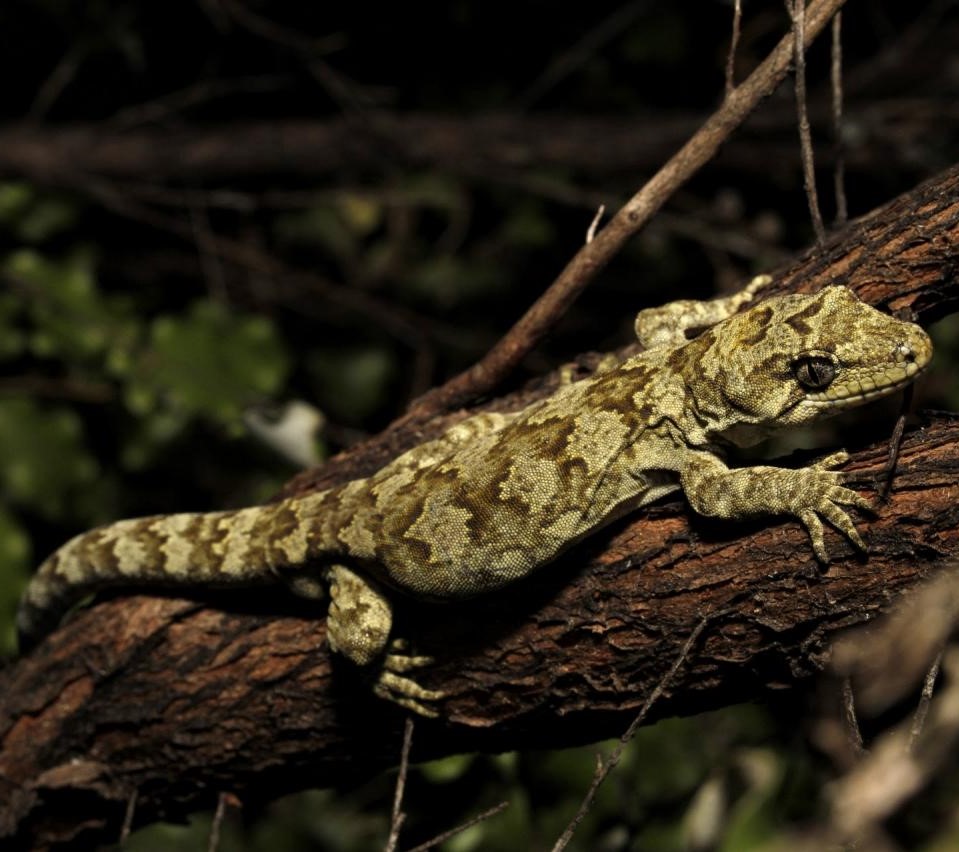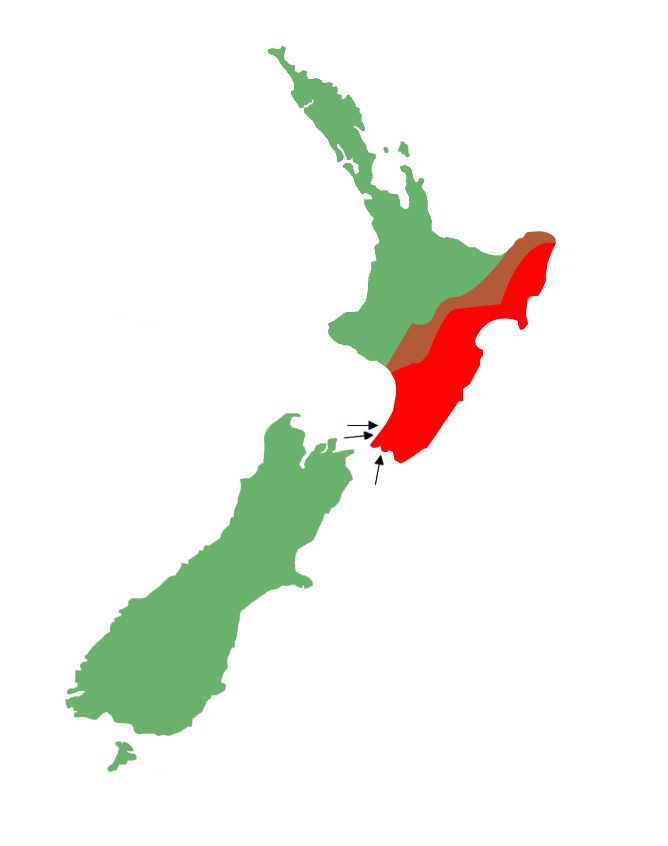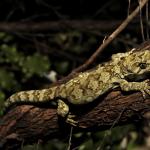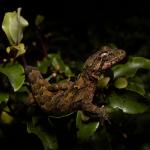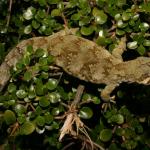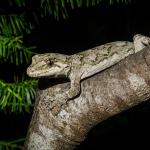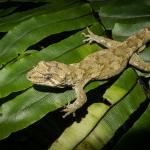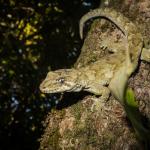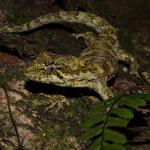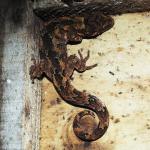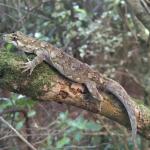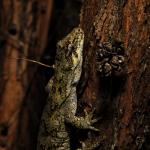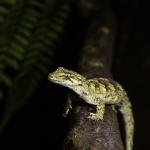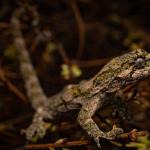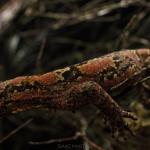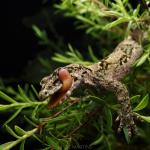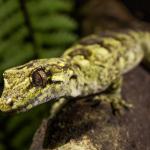- Home
- Herpetofauna Index
- Native
- Mokopirirakau "southern North Island"
Mokopirirakau "southern North Island"
Ngahere gecko
Mokopirirakau "southern North Island"
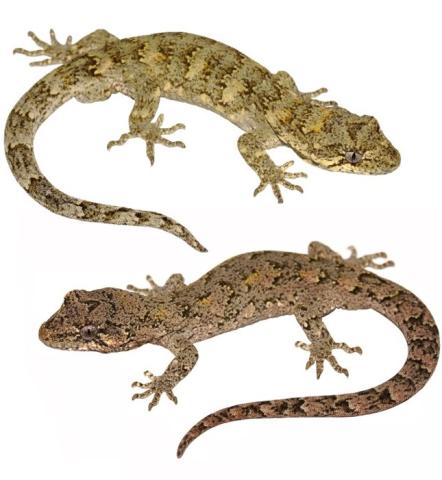
Length: SVL up to 96mm, with the tail being longer than the body length
Weight: unknown
Description
An intricately patterned gecko hailing from the forested regions of the southeastern North Island. Although similar in appearance to the forest gecko (Mokopirirakau granulatus), it is actually highly divergent, being the sister taxon to the rest of the Mokopirirakau genus.
These geckos are characterised by their light grey to dark brown/brown-red upper surfaces, which are decorated with transverse rows of double V or W-shaped markings running down the spine. These markings are often bordered by darker pigments (blacks, and dark browns) on the lower edge, and by lighter pigments (grey, and light brown) on the upper margins, with the space between markings often being a mix of the background colouration and the occasional flash of brighter colours (various shades of yellow, and red). Between the eyes, at the top of the head, there is often a V-shaped marking, whilst a dark band, bordered by light pigments (white to pink) often runs diagonally from the lower part of the eye and through the corner of the mouth. The sides often incorporate the trailing edge of the W/V-shaped markings, but primarily consist of the background colouration, becoming paler towards the ventral surface (stomach). The ventral surface is much lighter than the dorsal surfaces (white, beige, or cream), and are speckled with dark pigments (various shades of brown) giving them a mottled appearance.
As with all Mokopirirakau the mouth lining is bright orange, whilst the tongue is orangy-pink.
Can be differentiated from the co-occurring Raukawa gecko (Woodworthia maculata) based on toe morphology (narrow vs. wide), and general morphology (larger, and brighter colouration vs. smaller, and more drab). May be confused with the forest gecko (Mokopirirakau granulatus) along the northern extent of the range. It is almost impossible to differentiate these species, but in general forest geckos are more slender and the W-shaped markings are almost always connected, whereas the ngahere gecko is slightly more robust, and often has double V-shaped markings (disconnected W markings).
Life expectancy
Ngahere geckos have been recorded reaching ages of ~30 years in captivity, but are likely to exceed this.
Captive Mokopirirakau have frequently been known to live for upwards of 25 years, with some individuals topping the records at 40+ (D. Keal pers. comm 2016). The maximum age for wild animals is not known, however, it is likely that they can live at least as long as captive animals, if not longer.
Distribution
Southeastern North Island from East Cape to Whanganui (south of the Whanganui River, and southeast of the Raukumara, Te Urewera, and Kaweka Ranges), through to the Wellington region.
Currently occur on three islands in the North Island: one natural (Kapiti Island), and two translocated (Mana Island, and Matiu/Somes Island).
Ecology and habitat
The ngahere gecko is nocturnal (active at night), although they are also known to be active during the day due to their strongly heliothermic nature (an avid sun basker). As with many members of the Mokopirirakau genus they are primarily arboreal. They possess a strongly prehensile tail which acts as a third-limb/climbing aid when moving through shrubs and trees. They are known to occasionally mouth-gape and produce a high-pitched squealing sound when threatened by potential predators.
Being an arboreal species ngahere geckos are closely associated with a range of forested habitats, including swamps, scrubland, and mature forests (beech, podocarp, and broadleaf).
Social structure
The ngahere gecko is solitary in nature, although they can rarely be found cohabiting in the same refuge. Males show aggressive behaviour toward congeners, especially during the breeding season, and this is easily observable with many males showcasing scarring over their bodies. Neonates (babies) are independent at birth.
Breeding biology
Like all of Aotearoa's gecko species, the ngahere gecko is viviparous, giving birth to one or two live young either annually from around February. Breeding seems to occur from June through to August. As is the case with many lizard species, mating in Mokopirirakau may seem rather violent with the male repeatedly biting the female around the neck and head area. Sexual maturity is reached between 1.5 to 2 years.
Diet
Ngahere geckos are omnivores. They are primarily insectivorous in nature, but are also known to feed on the nectar, and small fruits of several plant species, and the honeydew of scale insects when they are seasonally available. Being arboreal in nature, their invertebrate prey tends to be predominantly composed of flying insects (moths, flies, beetles, etc.), and small spiders.
Disease
The diseases and parasites of Aotearoa's reptile fauna have been left largely undocumented, and as such, it is hard to give a clear determination of the full spectrum of these for many species.
The ngahere gecko, as with many of our other Mokopirirakau species, is a host for at least one species of endoparasitic nematode in the Skrjabinodon genus (Skrjabinodon poicilandri), as well as at least one strain of Salmonella. In addition to this, they are a known host for the ectoparasitic mite Neotrombicula naultini.
Wild Mokopirirakau have been found with Disecdysis (shedding issues).
Conservation strategy
Listed in the most recent threat classification as 'At Risk - Declining', due to a mix of land development/clearance of habitat, and predation by mammalian predators.
Interesting notes
The ngahere gecko gets its name from the reo word for forest, which is the main habitat where this species lives. The TAG name refers to its distribution, being the only Mokopirirakau found in the southern North Island.
"Moko-piri-rakau" is the Maori name for forest gecko, and means 'lizards that clings to trees.'
Despite the similarity in appearance and geographic proximity between Ngahere geckos and forest geckos (Mokopirirakau granulatus), the two species are not each others closest relatives. Ngahere geckos diverged from other species of Mokopirirakau much earlier, and forest geckos are most closely related to the black-eyed gecko (Mokopirirakau kahutarae) from the Marlborough and Tasman regions.
Although not formally described this species is likely to be named Mokopirirakau sylvestris after animals described by Walter Buller in 1881 (Buller, 1881), or as M. versicolor as per specimens described by William Colenso in 1885 (Colenso, 1885).
References
Hitchmough, R.A. (1997). A systematic review of the New Zealand Gekkonidae. Unpublished doctoral dissertation. Victoria University: Wellington, New Zealand.
Jewell, T. (2011). A photographic guide to reptiles and amphibians of New Zealand. Auckland: New Holland Publishers.
Robb, J. (1980). New Zealand amphibians and reptiles in colour. Auckland: William Collins Publishers Ltd.
Robb, J. (1986). New Zealand amphibians and reptiles. Auckland: Collins.
van Winkel, D., Baling, M. & Hitchmough, R. (2018). Reptiles and Amphibians of New Zealand: A field guide. Auckland: Auckland University Press, 376 pp.
Whitaker, T.A.H., & Gaze, P.D. (1999). Conservation of lizards in Nelson/Marlborough Conservancy, 44.

